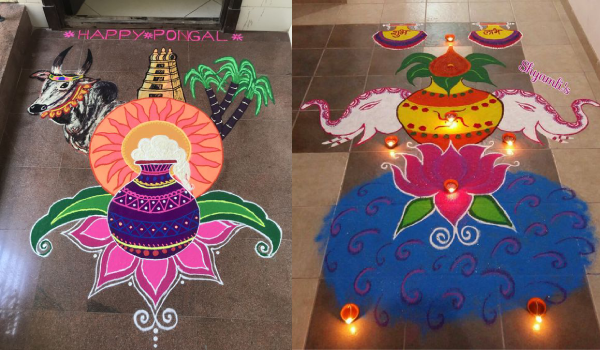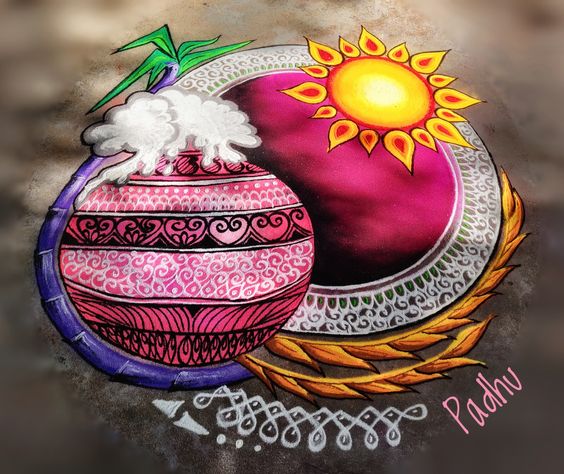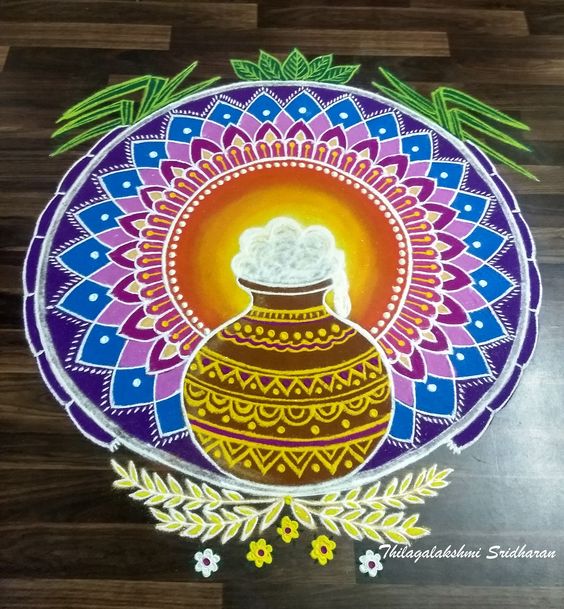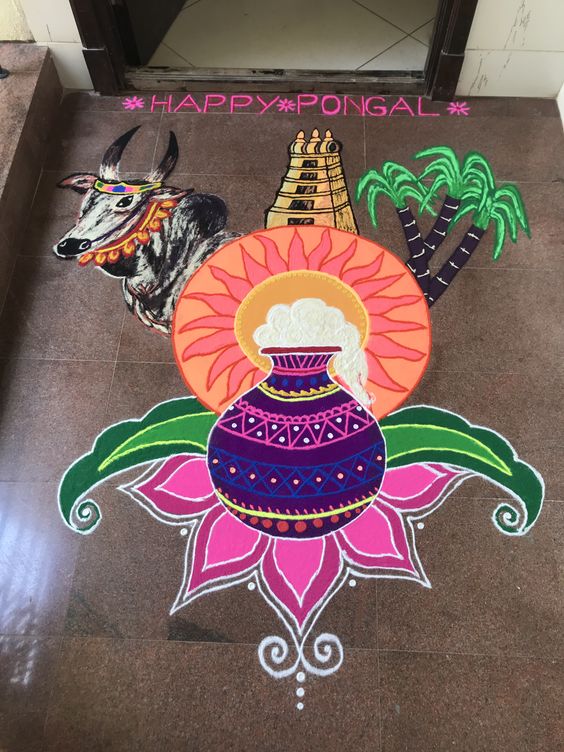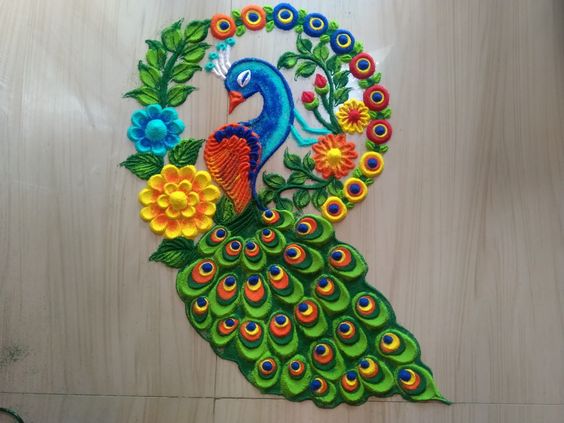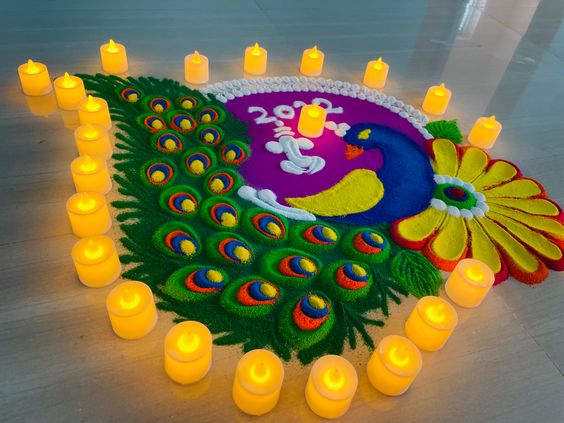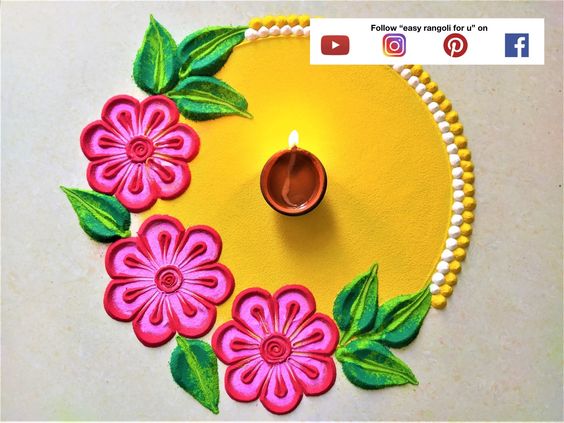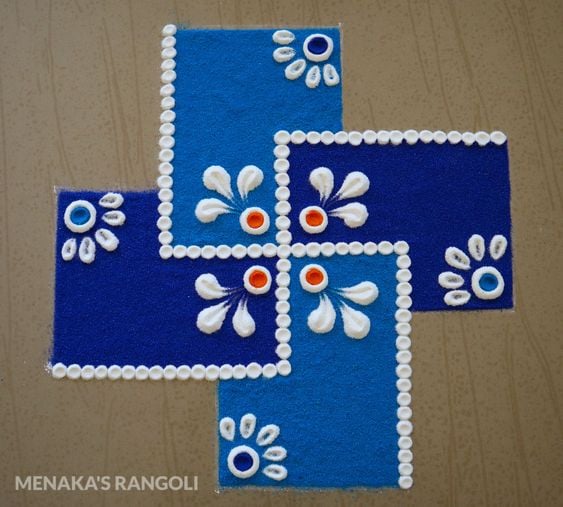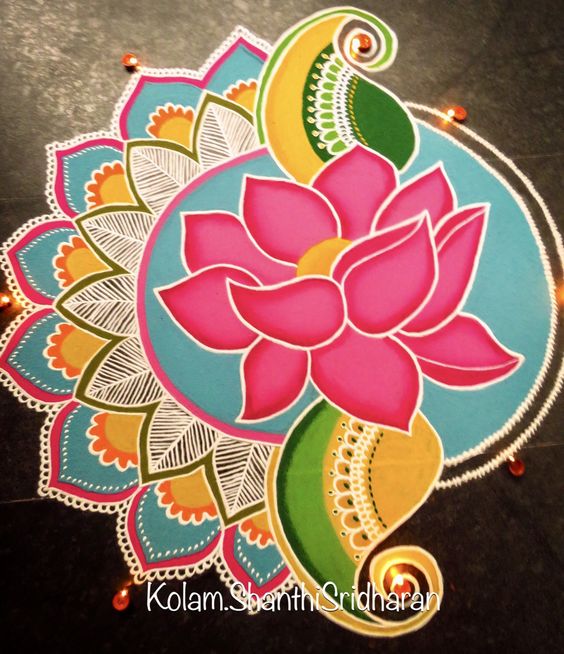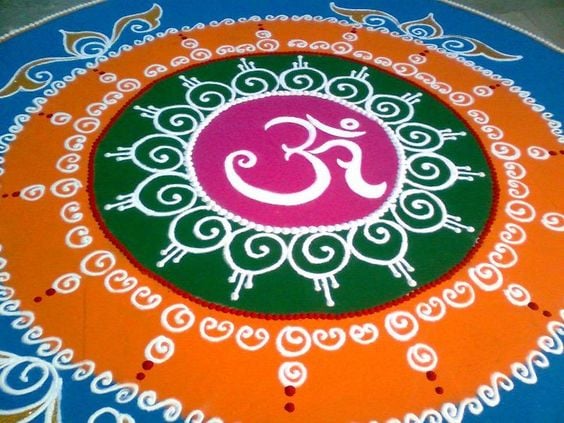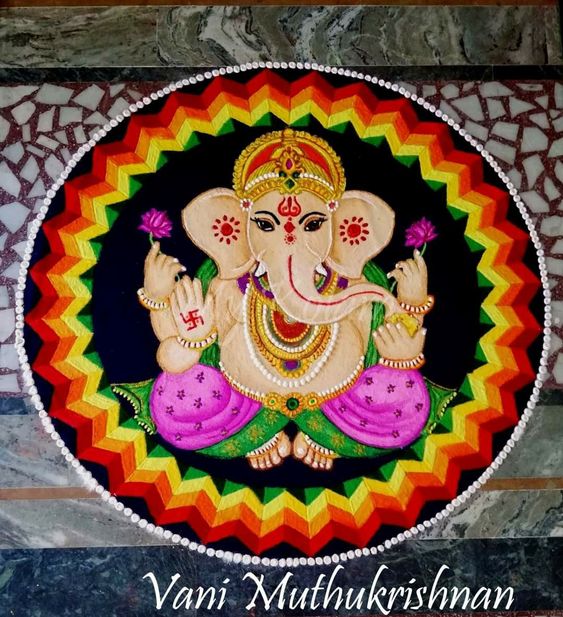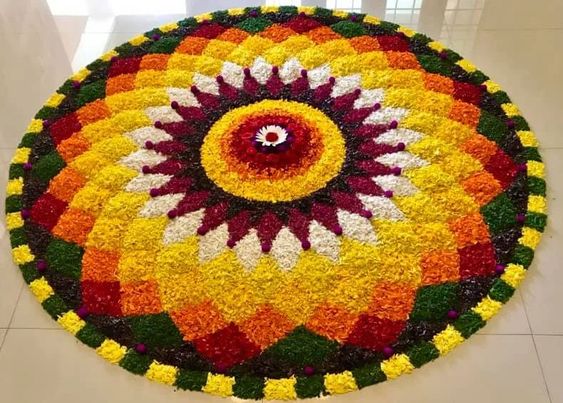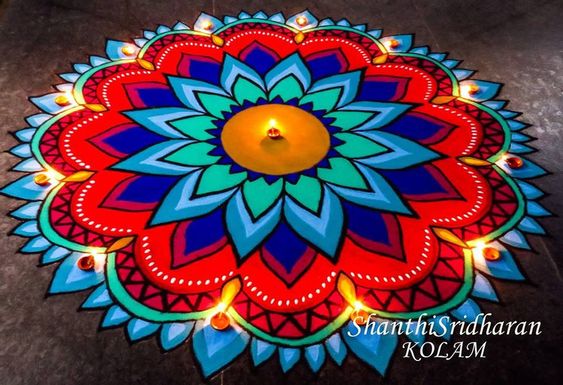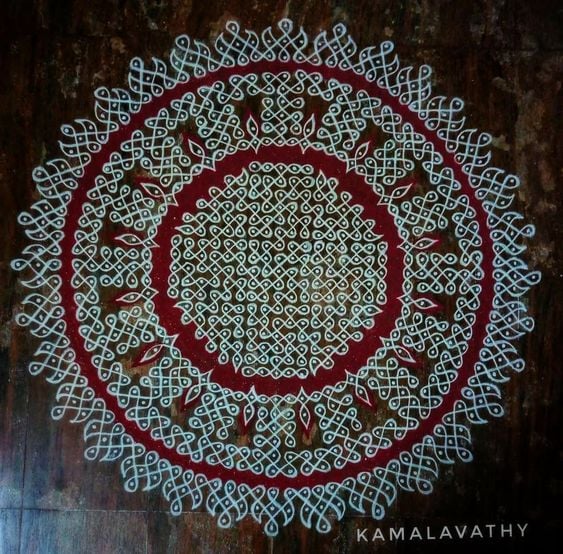Sankranti is a major festival celebrated in various parts of India that marks the beginning of the harvest season as well as the beginning of the sun’s journey northward. Rangolis, also known as kolams, play an important role in Sankranti celebrations. Rangolis are brightly coloured designs created with powders, flowers, or other materials. Here are some of the best Sankranthi Rangolis:
Peacock Rangoli: The peacock Rangoli is one of the most popular Rangolis for Sankranti. Peacocks are a symbol of beauty and grace, making them an excellent choice for a Rangoli. Colored powders or flowers can be used to make the feathers and a central circle for the head of a peacock Rangoli. A Peacock Rangoli is a traditional Rangoli design that depicts a peacock, which is regarded as a symbol of beauty, grace, and pride in many cultures. Peacock Rangolis are commonly created for festivals such as Onam, Navaratri, and Diwali.
The peacock is strongly linked with Lord Kartikeya, the Hindu god of war, who is said to ride a peacock. The Peacock is also linked to Lord Krishna, who is said to have worn a peacock feather on his head. Moreover, the Peacock feather is considered a symbol of beauty and grace, and it is said to have the power of protection and good luck. Creating a Peacock Rangoli is considered a sacred ritual and a way to pay tribute to the beauty, grace, and pride of the Peacock, as well as to seek blessings for new beginnings. It’s a way of honouring the Peacock and asking the gods for their blessings. Peacock Rangoli is a lovely way to embrace festivals and special occasions while also bringing good luck, prosperity, and happiness to the home.
Sun Rangoli: Seeing as Sankranti marks the beginning of the sun’s journey northward, the sun is a popular theme for Rangolis. To make a sun Rangoli, use yellow or orange coloured powder or flowers to make the sun’s rays, as well as a central circle for the sun.A Sun Rangoli is a traditional Rangoli design in which the image of the sun is featured. Sun Rangolis are typically created for festivals such as Sankranti, which commemorates the beginning of the sun’s journey northward.
Numerous cultures regard the sun as a symbol of energy and life, and creating a sun Rangoli is considered a sacred ritual and a way to pay tribute to the sun and seek blessings for new beginnings.
Swastika Rangoli: In Indian philosophy, the swastika is a sacred symbol that represents good luck and prosperity. This became pertinent to realise that making a Swastika Rangoli is a delicate task that prompts a strong sense of golden ratio and attention to detail in order to create an accurate and believable representation of the symbol. To help you with the design details, it’s a good idea to study the anatomy of the Swastika symbol and reference pictures of the symbol.Interestingly, the Swastika symbol has a special meaning in Hinduism and Buddhism; it is regarded as a sacred symbol of good luck and prosperity. The symbol has recently been associated with the Nazi regime and has been banned in many countries. Creating a Swastika Rangoli is considered a sacred ritual and a way to pay tribute to the symbol while also seeking blessings for new beginnings. If you want to make a Swastika Rangoli, you should be aware of the symbol’s historical context and understand its cultural significance.
Lotus Rangoli: It must be vital to note that making a Lotus Rangoli requires a strong sense of symmetry and attention to detail in order to create an accurate and believable representation of the flower. To better serve you with the design details, research the contours of a lotus flower and look at pictures of lotus flowers. When making a Lotus Rangoli, it’s also important to select the appropriate colours to represent the flower. Pink and white are the traditional colours for a lotus Rangoli, which can be made with Rangoli powder, coloured sand, or real flower petals.
Om Rangoli: Om Rangoli is a traditional Rangoli design that emphasises the image of the Om symbol, which is considered the most sacred symbol in Hinduism and represents the sound of the universe. Om Rangolis are typically made for festivals such as Diwali and other auspicious occasions. The Om symbol has special meaning in Hinduism because it is believed to be the sound of the universe and the source of all energy. Creating an Om Rangoli is considered a sacred ritual and a way to pay tribute to the symbol and seek blessings for new beginnings. The Om symbol is thought to bring good fortune, peace, and prosperity to the household and is frequently used as a symbol of spiritual awakening and connection with the divine.
Elephant Rangoli: Elephants are a popular choice for Rangolis because they are a symbol of strength and wisdom. To make an elephant Rangoli, first create the elephant’s body with grey or brown powder or flowers, then add details like the trunk and ears. It’s worth noting that making an Elephant Rangoli is a delicate task that necessitates a good sense of proportion and attention to detail in order to create an accurate and believable representation of the elephant. It’s a good idea to study elephant anatomy and look at elephant pictures to help you with the design details. Furthermore, keep in mind that elephants are wild animals, and using real ivory to make Elephant Rangolis is not only unethical, but also illegal in many countries. It is recommended that Rangoli powder, coloured sand, or flowers be used to create the design.
Pookalam Rangoli: Pookalam is a Rangoli design unique to Kerala that is widely used during the Onam festival. Pookalam is made by arranging different coloured flowers in a circular pattern, which is then embellished with various other motifs and designs. It is regarded as one of the most beautiful Rangoli designs.
Pookalam Rangolis are an excellent way to express one’s creativity while also practising patience and precision. The use of different coloured flowers in a Pookalam can give it a vibrant and beautiful appearance. It’s a great addition to any festival or special occasion, and you can make it as simple or as complicated as you want.
Mandala Rangoli: Mandalas are geometric patterns that are thought to represent the universe. To create a mandala Rangoli, use different colours of powder or flowers to create the design, and then add a border around it. Mandala Rangolis are an outstanding way to express one’s creativity while also practising patience and precision. They can be as simple or as complex as you want, and the design possibilities are limitless. A mandala rangoli’s use of symmetrical patterns and the repetition of shapes and colours can create a meditative and calming effect, making it an ideal addition to any festival or special occasion.
Dotted Rangoli: Dotted Rangoli, also known as “pulli kolam” in Tamil and “muggu” in Telugu, is a popular traditional Rangoli style created by drawing a design with dots and then connecting the dots to form a pattern. The dots are usually arranged in a grid pattern and serve as a guide for creating the final design. Dotted Rangoli is a popular traditional Rangoli style. Pookalam Rangolis are an extremely good technique for expressing person’s creativity while somehow applying patience and precision. The use of different coloured flowers in a Pookalam can give it a vibrant and beautiful appearance. It’s a great addition to any festival or special occasion, and you can make it as simple or as complicated as you want. Pookalam Rangoli is more than just a decoration; it is also a sacred ritual and a way to honour nature and the environment.
Rangolis can be made more vibrant and beautiful by combining different coloured flowers and powders, as well as using diyas and flower petals. Rangolis are used for more than just decoration; they are also considered a sacred ritual.
Source: Pinterest
